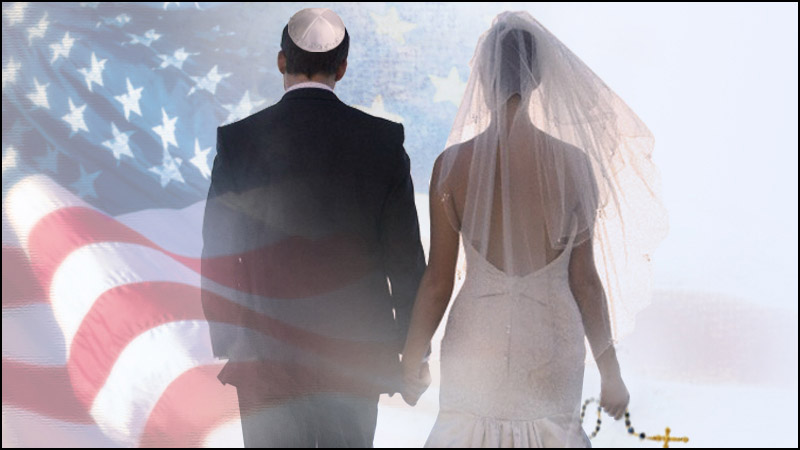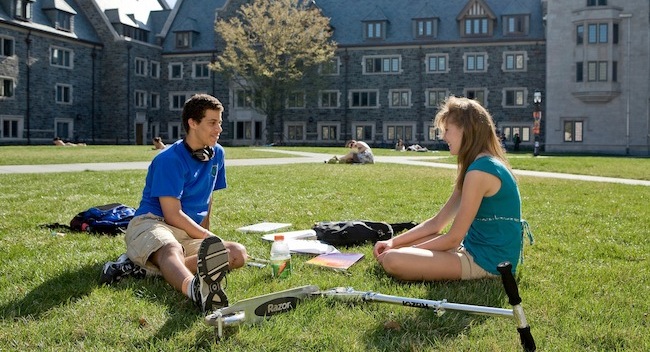In his characteristically thoughtful essay, Jack Wertheimer takes up the banner of those many American Jews who regard their Jewishness as very important to themselves, to their children, and to the future of American Jewry at large. As against the seemingly entrenched tendency to view intermarriage as inevitable, if not normative, Wertheimer boldly declares that the battle is not over. Rejecting the “defeatists” among Jewish clergy and in the organized Jewish community who have adopted a policy of no-questions-asked “inclusiveness,” he urges the opposite: reinforcing the boundaries between Jewish and non-Jewish behaviors and actively encouraging the conversion of Gentile partners and spouses.
Intermarriage does indeed loom large for American Jews who are justifiably concerned about the transmission of Jewish religious culture to the next generation. And yet, when we place intermarriage in the context of (in Wertheimer’s words) the “broader trends in American society,” we see a more pervasive problem. Intermarriage is just one current amidst a sea change in patterns of family formation in the United States.
From the 1960s until today, the prominence of heterosexual two-parent endogamous families has receded as diverse household models have increased. Skeptical American singles continue to view marriage and parenthood as abridgements of personal options. Partnered or single men and women, among them some number of gay and lesbian couples who eagerly pursue religious marriage ceremonies and the legal entitlements of conventional families, create households with single mothers and fathers, two mothers, or two fathers. In addition, about one-third of Americans marry across religious, ethnic, and racial lines, producing a new generation impatient with census questionnaires with a single box for ethnicity. Meanwhile, conventional family life has been periodically subjected to scathing critique in the academic press and the popular media. Against the backdrop of these sweeping changes, intermarriage between Jews and non-Jews is often regarded as just one more family construction among many.
To an extent not always appreciated, intermarriage is also deeply entangled with the phenomenon of delayed marriage. The four years of college—once a de-facto marriage market—now reputedly host a “hook-up culture” instead. Even those who don’t participate in casual sexual encounters often choose to spend their time in friendship groups rather than in romantic dyads leading to permanent commitments. Except for the religiously observant, undergraduates commonly report themselves to be “not ready” for such commitments. All this contributes to the widespread postponement of what the New York Times Magazine has dubbed the five sociological milestones of adulthood: “completing school, leaving home, becoming financially independent, marrying, and having a child” (August 22, 2010).
What does this mean for Jews? College attendance is often anecdotally blamed for intermarriage, but the opposite is true: universities bring Jews together with other Jews in peer relationships denser than most will ever experience again. Moreover, Jews who identify life partners during their college or graduate-school years are far likelier to marry fellow Jews than those who wait until they are out in the work world—which is increasingly the normal pattern today. A Princeton alumna recently made sparks fly when she advised today’s female undergraduates to look for husbands during their years on campus. Her advice is especially salient for young Jews.
By contrast, once they begin to pursue first jobs or graduate or professional training, young Americans today are far less likely to become engaged than to drift into cohabitation. In turn, such living arrangements often bypass “mindful” emotional commitments. This lack of deliberateness may be one reason why couples who live together and marry later, sometimes much later, have twice the divorce rate of those for whom engagement precedes cohabitation or marriage.
This is also true of marriages across ethnic and religious boundaries. Here, too, the Jewish case is similar. Many American Jews in their twenties and thirties are not actually in the process of deciding, in Wertheimer’s words, “whom they will date and marry, and, when they marry a non-Jew, . . . how their home will be oriented, how their children will be educated, and which aspects of Judaism and of their Jewish identities they will compromise for the sake of domestic peace.” On average, intermarrying Jews marry three years later than in-marrying Jews, often cohabiting in the interim, and marriages between Jews and non-Jews, like marriages after uncommitted cohabitation, are twice as likely to culminate in divorce.
I might mention here another factor, more specific to the Jewish situation, that plays a distinctive role in the avoidance by Jewish singles of romantic relationships with other Jews. That factor is negative stereotypes, especially of Jewish women. Although Jewish men and Jewish women are almost equally likely to marry non-Jews today, their narratives are different. The men often cite certain supposedly off-putting characteristics of Jewish women. For their part, the women are much more likely to articulate an initial preference for Jewish men before they later accept a non-Jewish partner. Moreover, once in a mixed-faith relationship, Jewish women (as Wertheimer notes) are likelier than Jewish men to insist on raising Jewish children, and to act on that intention. Conversely (and exceptions duly noted), Jewish men who marry non-Jewish women are statistically less likely to implement Jewish connections or to provide their children with a Jewish education.
This brings us to the matter of children in general. After they marry (if they do marry), contemporary American Jews—and this includes the in-married as well as the intermarried—often postpone starting a family until their careers are better situated or they can move into more capacious living quarters. Since even the latest figures show that female fertility levels gradually begin to decline around age thirty-two and then drop rapidly after thirty-seven, with one out of five women who try to conceive in their late thirties suffering from infertility, couples who delay are more likely to find themselves struggling with this unwanted predicament.
How does this affect the intermarriage issue? For the parents of today’s young American Jews, the question becomes not “will I have Jewish grandchildren?” but “will I have any grandchildren?” Such parents, whether or not they go to the length of paying to freeze their daughters’ eggs as a kind of insurance policy, as some reportedly do, understandably come to view intermarriage as a lesser evil, and will more readily pressure their rabbis and the Jewish community at large to accept their (finally) marrying children with open arms. The word “intermarriage,” after all, contains the word “marriage,” and that is enough for them.
Differences of sensibility between Jewish men and Jewish women aside, there is no doubt that, as Wertheimer stresses, “intermarried families have considerably lower chances of raising committed Jews.” And he rightly demands that we focus on policy implications—on “what is to be done.” Yet in this area as well, focusing primarily on the intermarriage taboo obfuscates the more pervasive battle for marriage itself, which if anything requires even earlier interventions in the lives of young Jews.
Partisans of traditional Jewish marriages between two Jews—and I count myself enthusiastically in their company—do have powerful tools at their disposal. Jewish connections and Jewish marriage do not happen by accident. By the same token, intermarriage is not the random and indiscriminate phenomenon sometimes portrayed by the Jewish outreach industry, an industry properly and effectively targeted by Wertheimer.
Marriage between two Jews is demonstrably influenced by early and continuing educational interventions that are rich in opportunities for peer interaction. High-quality Jewish education (not only in day-school settings) that lasts through the teen years, summer camps, college classes in Jewish studies, and Israel trips dramatically increase the likelihood that Jews will marry Jews and create unambiguously Jewish homes. These interventions are effective partly by socializing young Jews to feel connected to Judaism and to the Jewish people. True enough, educational socialization doesn’t come with a guarantee, and obviously it doesn’t work for everybody; nothing does. But study after study makes clear that if the goal is in-marriage, the path lies through creating educational opportunities for teens and young adults in every sizeable Jewish locale.
Individuals, families, and communities must also “lean in” to early, ongoing, and open conversations about the need for mindfulness in selecting romantic partners—and about the positive rewards of taking on personal commitments and responsibilities. Individuals, families, and communities need to show, by example and by word, why Jewishness matters—to create in sons and daughters an appreciation of the appeal, and the sheer sexiness, of Jewish men and women.
Because these issues tend to present themselves in personal terms, they are difficult to deal with. Some individuals do not wish to marry, and should not marry. Some should not have children. But for the many Jews who adhere to the enduring personal connections and responsibilities of partnership, marriage, and parenthood, and for all those who aspire to that state for themselves, a focus on positive goals—rather than on what we want to avoid—is central to the dynamic survival of the American Jewish community. The larger battle is for marriage itself.
_______________________
Sylvia Barack Fishman, the Joseph and Esther Foster professor of Jewish and contemporary life at Brandeis University and co-director of the Hadassah Brandeis Institute, is the author of, among other books, The Way into the Varieties of Jewishness and Double or Nothing?: Jewish Families and Mixed Marriage.
More about: Intermarriage, Jack Wertheimer, Jewish identity, Jewish marriage





